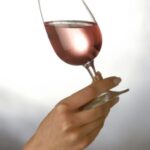There are certain basic rules of wine tasting etiquette whether you’re at a party or travelling around wine country. Wine tasting can be a fun and interesting experience! Taking cellar tours and wine tastings, learning about the terrior and experiencing the beauty of the vineyards and the grapevines brings a new appreciation for the hard work that goes into making each wonderful bottle of wine.
Many people are intimidated by the thought of a wine tasting and avoid wine tasting rooms altogether. But at wine tastings, be they at a winery, a wine store or at a house party, you will learn so much and will make new friends who share your interest in tasting wine.
Wine tasting for beginners starts here! Familiarize yourself with these wine tasting etiquette tips to help you to become more comfortable as you advance from a novice wine taster to a wine connoisseur.
Wine Tasting Tips
Enter a wine tasting room and expect to be greeted by a wine pourer or even by the winemaker or owner. They are there to talk about the winery, the grapes that are grown, types of wine they make and which wines are available to taste. It is improper wine tasting etiquette to ignore these details as they are part of the overall wine tasting experience. Greeters can immediately tell if a visitor is there only for a drink and not truly interested in the types of wines offered.
Here you will learn how many wines are offered for tasting and what the price is to taste the wines. Wine tasting prices vary from tasting room to tasting room. Some offer several tastes and some offer just a few. Some but not all tasting rooms include a souvenir glass as part of the tasting. It is not proper wine tasting etiquette to ask for a tasting of wine for free.
Peruse the wine tasting menu before you head to the tasting counter to get an idea about the wines you’re interested in tasting. If you need an explanation about the types of wines offered, don’t hesitate to ask the greeter or staff member as you should expect them to be knowledgeable about their wines. Concentrate on tasting wines that you are interested in learning about. It is okay to skip any of the wines offered on the wine tasting menu. And, if you taste a wine that you do not care for, it is perfectly acceptable wine tasting etiquette not to finish that particular tasting of wine.
It is not proper wine tasting etiquette to ask for bottles to be opened that are not part of the tasting menu. In my own wine tasting experiences, I have often been asked to taste wines that are not on the wine tasting menu(sometimes called special reserve) or to taste barrel wines that are available to purchase as wine futures. These instances are exceptions and not the rule and were initiated by the staff member or winery owner. If you are fortunate enough to be offered these types of wine tastings, be sure to thank them for their courtesy.
One of the basics of wine tasting is to understand that the wine poured is a tasting pour. So, don’t expect to receive a full glass of wine and do not ask for more than a tasting pour as it is not proper wine tasting etiquette to do so. I once went to a wine tasting room where a group of six visitors wanted to share one wine tasting. This too is improper wine tasting etiquette. It would be in better taste to purchase a full bottle of wine for the group to enjoy.
Tasting the Wine
The basics of wine tasting, whether it is in a tasting room, wine store or at a party, include how to taste the wines. Here are some fundamental facts about wine tasting:
1.) When the wine is poured, look at it, especially around the edges. Holding the glass by the stem and tilting the glass makes it easier to see the way the color changes from the center to the edges.
2.)Sniff the wine so that you can compare the fragrance after swirling it.
3.) Gently swirl the wine in the glass. This increases the surface area of the wine allowing it to reach your nose. It also allows for oxygen into the wine, helping the aroma to open up.
4.) While swirling the wine, note how slowly it runs back down the side of the glass. This is how you note the wine’s. More viscous wines are known to have “legs” and are most likely to have higher alcohol content.
5.) Sniff. Hold the wine glass a few inches from your nose and then let your nose go into the wine glass. Note any fragrance you may smell.
6.) Sip. Take a sip of the wine and roll it in your mouth before swallowing to make sure that it is exposed to all of your taste buds. You may detect sweet, sour, savory, bitter or salty. Here is where you may also detect texture.
7.) Aspirate through the wine. Pursing your lips, draw some air into your mouth and exhale through the nose. This process opens the aromas of the wine, allowing them to reach your nose. The nose is the only place where you can truly detect the aroma of the wine.
8.) Take a second sip of the wine. This time, bring in some air as you sip. Note any subtle differences in flavor or texture.
9.) After swallowing, note the aftertaste and how long the finish lasts.
10.) Write down your experience. Most wine tasting rooms will provide a wine tasting scorecard or sheet to jot down your impressions of the wine you tasted. Wines have four basic characteristics: taste, tannins, alcohol and acidity. A good wine will have a distinct balance of all four characteristics. Aging the wine softens the Tannins. Acidity will soften during the lifetime of the wine. Alcohol stays the same no matter how old the wine gets.
Cleansing the Palate and Spitting Wine
Most wine tasting rooms offer water to cleanse the palate or to rinse the wine glass between tastings, especially when switching from white wines to red wines.
Experienced wine connoisseurs who taste several wines at one tasting will spit residual wine into spittoons between wine tastings to avoid over-indulgence and deadening the palate.
If you can’t bring yourself to spit (don’t feel bad, I can’t do it, either), make sure that you have eaten something substantial before going to a wine tasting. Alcohol is absorbed more slowly on a full stomach than an empty stomach.
Other Wine Tasting Tips
Generally speaking, part of a wine tasting includes small snacks such as wine crackers or plain pieces of bread to cleanse the palate after tasting the wines. Do not take handfuls of these snacks; that would be a wine tasting etiquette “no-no”.
Courteous wine tasters try not to interfere with the ability to smell wines. Avoid smoking or wearing heavy perfumes or after-shave when you attend a wine tasting.
Gum and breath mints alter the taste of wine during wine tastings. Avoid using them when attending a wine tasting.
Keep your opinions to yourself. Perhaps the wine you tasted wasn’t exactly what you liked. If so, keep your opinion to yourself until others in your group have had a chance to taste.
If you went to a winery and enjoyed the wine tasting experience, it is perfectly acceptable to leave a tip for the wine pourer.
Wineries hope that once you have tasted their wines that you will want to purchase bottles of their wine. Support these hard working, local wineries by purchasing a bottle (or more) of your favorite wines.
Do not get “tipsy” at a wine tasting. If you know that you will taste several wines, appoint a designated driver to get you home safely. If you’re touring with a group, consider hiring a wine tour company or limousine service that can safely take you wine tastings.
Take home a souvenir! Many wineries also offer wine related gifts . Take the time to browse wine gift selections – you never know what you may find!




